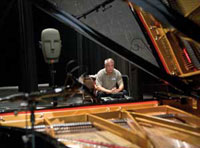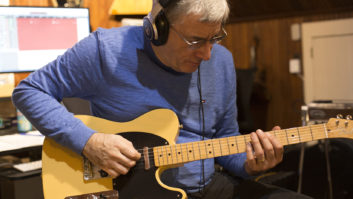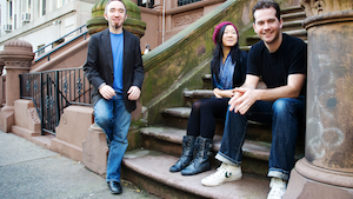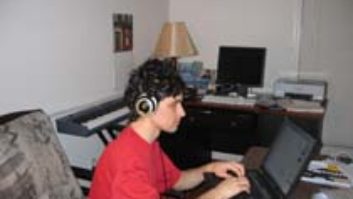
Zenph Studios’ John Walker observes the re-recording setup onstage at the Shrine Auditorium
As many a frustrated pianist can tell you, it’s nearly impossible to play like jazz piano immortal Art Tatum. Such was his improvisational genius and jaw-dropping dexterity that Tatum’s peers shook their heads in disbelief at his prodigious keyboard feats. Yet now there’s an amazing CD that captures every aspect of Tatum’s brilliance — with no pianist in sight! Art Tatum: Piano Starts Here — Live at the Shrine is a remarkable modern “re-performance” of a 1949 Tatum concert LP (as well as four songs from a 1933 studio session), accomplished by programming every nuance of Tatum’s playing on those recordings onto software that was then “read” by a Yamaha Disklavier Pro grand on the same L.A. Shrine Auditorium stage that Tatum graced nearly 60 years ago.
“The Disklavier cannot do what we need so they built a different model called the Disklavier Pro,” explains John Walker, whose Raleigh, N.C.-based Zenph Studios (www.zenph.com) software company is responsible for the sophisticated programming. “I wish they’d called them ‘Ford’ and ‘Ferrari,’ because that’s how significant the difference is between those two instruments. Now that the Disklavier Pro exists, you can get thousands more levels of touch and nuance, so now we can really replicate what a musician does.”
We’re talking about a literally microscopic level of data analysis and coding — the tonal coloring, the attack and decay of each note, every pause and pedal move is exactly replicated on high-resolution MIDI files and then “played” back on the Yamaha (or new similar models from Steinway and Bösendorfer).
Piano Starts Here marks the second Zenph release for Sony BMG: Last year, a re-performance of Glenn Gould’s 1955 recording of Bach’s Goldberg Variations came out to rave reviews. It was produced by Grammy-winning classical and jazz producer Steven Epstein and recorded by Epstein’s longtime colleague, Richard King. They collaborated on the Tatum disc, as well.
In a sense, once the programming is perfected and tried at Zenph Studios, there’s no mystery about the performance’s quality to be recorded; the producer’s role is mainly before the actual recording, “With the Tatum [album],” Epstein says, “because there wasn’t really any written material, the idea was to become as familiar as possible with the original recordings to get a sense of any technical aberrations or musical quirks. Then it’s a question of correlating those [original recordings] with what I heard in the concerts.”
Sonically, the actual recording of two shows — complete with audience — at the Shrine in September 2007 could have been any other hi-res live session. Though the files created in North Carolina had been completed to everyone’s satisfaction, there was still slight apprehension going into the Shrine. “It seemed almost too loud and forceful in the [Zenph] studio,” Epstein says. “But Tatum knew what he was doing. He was projecting in this big place.” Walker adds, “God bless Steve Epstein’s ears — he found the right spot on the stage where everything worked musically — every accent, every rest, every pedaling.”
King says, “The idea was to do a 5.0 surround recording as simply as possible to capture it as accurately as possible. So we had five microphones — transformerless DPA 4006TLs — straight to the [Millennia] mic preamp, straight into the Sonoma [DSD digital workstation]. As a safety net, we had a pair of Sennheiser MKH 40s deep in the piano — as you normally would for a jazz piano recording — and the [binaural] dummy head. We also added two Neumann cardioids for audience mics. When we went to mix [at Legacy Studios in New York City] we didn’t use the piano mics at all and the audience mics were only brought in and out for applause, so they weren’t part of the main pickups. It really ended up being the five-DPA array with a tiny amount of Lexicon 960 reverb. [The converters were Meitners.] Everyone was concerned with the sound matching timbre-ly the sound of the original live recording, but that was quite dirty and didn’t have a lot of air in it so we had room for our own creativity.”
The result is an astonishing re-creation — Tatum for the digital age. What’s next for Zenph? Besides a new Tatum with Big Band disc, expect to hear re-performances of Rachmaninoff, Rubenstein, Ellington and others. They’re close to perfecting their standup bass programming, and drums and horns aren’t too far off. “We think voice may be 10 years away,” Walker says. Don’t bet against perfect Caruso in 2018.





